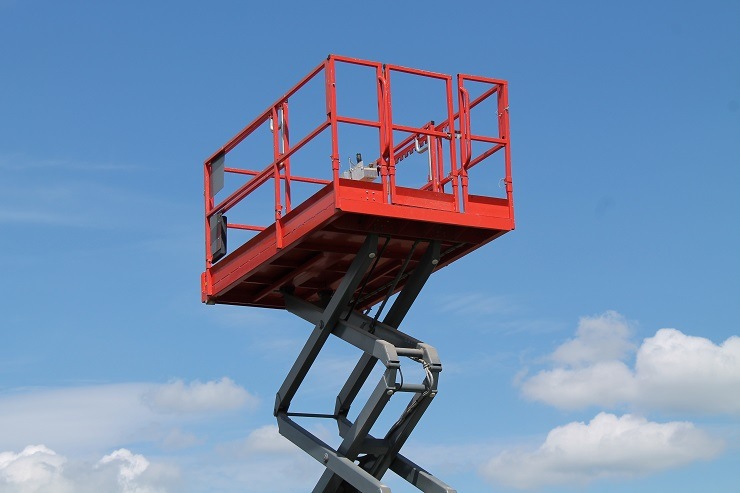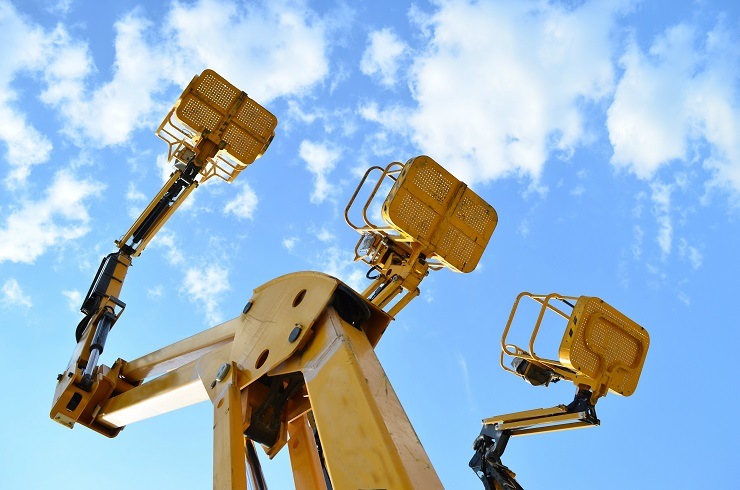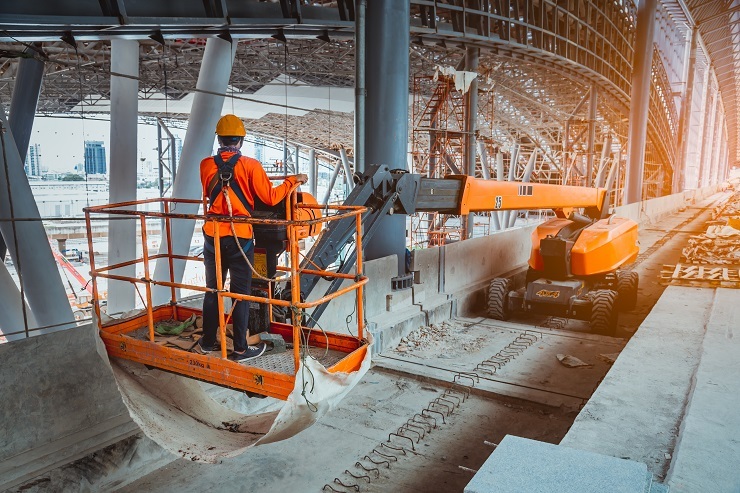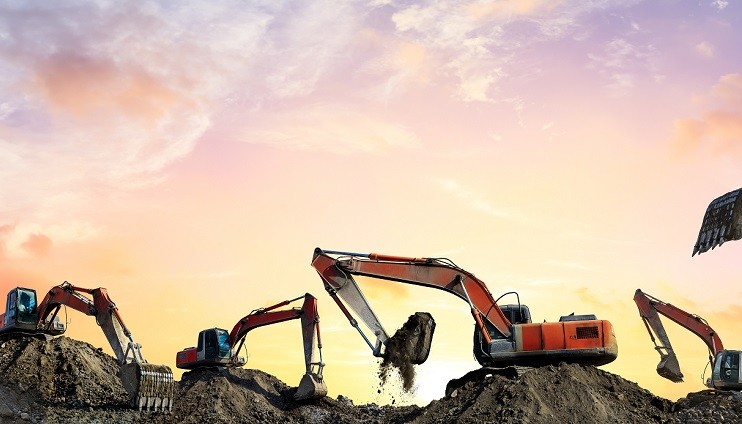During construction projects, workers frequently need to safely and efficiently access high areas that a conventional ladder cannot reach. For this reason, lifts are a necessity.
Construction lifts, also called man lifts, aerial lifts and aerial work platforms (AWP), transport workers up and down different levels at a worksite. They may also be used to carry materials and equipment as well as remove construction waste and debris.
Generally, lifts consist of an aerial platform and a mechanism or arm that are mounted on a vehicle. There are several types of AWPs, with significant differences among them. Two of the most used are the scissor lift and the boom lift.
Understanding the differences between the boom and scissor lift is key to choosing the right one for a project. In this article, we discuss the major differences between the scissor and boom lifts, their applications, in addition to their advantages and limitations. This will help you make an informed decision when determining which type to rent or buy for your next project.
What Is a Boom Lift?
The boom lift, also called a cherry picker and basket crane, is specifically designed for very high jobs. In fact, among all types of construction lifts, the boom lift is the highest-reaching AWP.
A boom lift has a platform or bucket connected to a jointed crane or arm that is attached to a ground base on wheels or tracks. The arm is controlled by hydraulics, allowing the operator to move it horizontally and vertically.
Types of Boom Lifts
There are two main types:
Articulating Boom Lift
This type of boom lift has an arm with multiple joints or knuckles that allow it to reach over and around obstacles. It is mounted to a turntable, allowing it to rotate fully.
Applications of Articulating Boom Lifts
The articulating boom lift can lift workers up to 100 feet. It can be used indoors and outdoors. Its maneuverability and versatility make it ideal for projects that require working in tight, crowded or hard-to-reach spaces, such as:
- Maintenance work
- Tree care
- Electrical installations
- Painting ceilings
- Inspecting bridges, buildings and utility infrastructure
- Agriculture, such as installing irrigation systems
Telescopic Boom Lift
Sometimes referred to as a straight boom, the telescopic lift is preferred for projects that require the greatest horizontal and vertical outreach possible. It comprises a stable base frame to prevent tipping, a platform and a hinged extendable arm that can reach further than an articulating boom lift. Depending on the make and model, a telescopic boom lift can lift a worker to 185 feet or even higher.
Unlike the articulating boom lift, the telescopic boom lift has no joints in its arm. This means it can only be extended straight or at an angle. This type of boom lift is best suited for projects that require access to very high places.
Telescoping boom lifts are not ideal for projects in tight spaces, as they need room to turn. However, they can be used indoors and outdoors, as long as there is enough space to account for their tail swing and arm length.
Applications of Telescopic Boom Lifts
Telescopic boom lifts have various applications, including:
- Lighting work
- Erecting scaffolding
- Construction on multistory buildings
- Agriculture (fruit picking and crop harvesting)
- Tree trimming
- Bridge construction

What Is a Scissor Lift?
A scissor lift is a type of aerial work platform used in construction, maintenance, warehousing and other applications that require workers and equipment to be elevated. However, unlike boom lifts, scissor lifts can only move up and down—They cannot move horizontally.
Scissor lifts are named after the design of their lifting mechanism, which consists of tubes in a crisscross pattern resembling scissors.
A scissor lift comprises five main parts: the power source, base, cylinders, scissor legs and platform. The scissor lift’s base provides stability and guides the rollers at the bottom of the scissor legs. The cylinders move the scissor legs up and down. The scissor legs support and elevate the platform, allowing the worker to reach high spaces.
The main advantage of the scissor lift is its stability. Generally, scissor lifts have large platforms capable of holding up to four workers, their equipment and tools. Depending on the type, brand and model, a scissor lift can reach anywhere from 20 to 60 feet.
Applications of Scissor Lifts
Scissor lifts are mainly used indoors. Their applications include:
- Construction, for accessing high spaces such as roofs and windows
- Maintenance and repair of buildings
- Maintenance and repair of powerlines and other utility infrastructure
- Warehousing for loading, unloading and moving goods, as well as installing storage systems
Types of Scissor Lifts
There are five main kinds of scissor lifts. These are:
- Electric
- Hydraulic
- Diesel
- Pneumatic
- Rough Terrain

Boom Lift vs. Scissor Lift: Major Differences
Scissor lifts and boom lifts are two distinct types of AWPs, and each has its own features and benefits.
Scissor lifts can lift vertically but not horizontally, making them well-suited for tasks that require reaching high places in a straight-up motion. They’re also ideal if there is a need for more than one worker to be on the platform simultaneously, as scissor lifts have larger platforms capable of bearing heavy loads.
With their stability and reliability, scissor lifts are best for indoor projects and even surfaces, except for the rough terrain type. Rough terrain scissor lifts are ideal for indoor and outdoor projects with challenging outdoor surfaces, such as rocky or uneven ground.
On the other hand, boom lifts have extendable arms that allow for vertical and horizontal outreach. Due to their size, boom lifts are best for outdoor projects, such as construction, maintenance and repair. Both telescopic and articulated types can carry heavy loads.
The flexibility of articulated boom lifts makes them best for projects that involve working in hard-to-reach areas and navigating obstacles on a worksite. Meanwhile, telescopic boom lifts are well-suited for projects that require reaching very high spaces.
Boom Lift vs. Scissor Lift: Factors to Consider
Ultimately, the choice between a boom lift vs. a scissor lift depends on factors such as:
- The type of project you’re working on
- How high you need workers to be to access the work area
- Whether you need horizontal as well as vertical reach
- Terrain type
- Available workspace
Scissor and boom lifts are useful equipment that helps make projects such as construction and building or facility maintenance more manageable, efficient and safer. Each has its own advantages, and understanding the differences helps ensure you select the right one for the job.
Find the Best Construction Lift for Your Project at National Dispatching
National Dispatching, a trusted full-service equipment rental group, offers a wide range of aerial work platforms (AWPs) for all your construction needs. These include boom and scissor lifts as well as material handling, earthmoving and compaction equipment.
Additionally, we provide services such as trucking and subcontracting to small and large contractors.
View our AWPs for rent and inquire today. You may also contact us to learn more about our other products and services.



